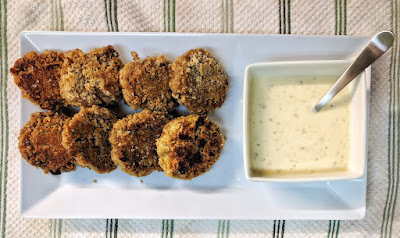2 cans salmon
2 eggs
1 bag plain pork rinds
Salt and pepper (Ruthy blend from Penzeys)
1 C. oil
High sided skillet.
Gently heat oil over medium heat. Crush pork rinds until they resemble bread crumbs. Pour 1/2 C. Into large mixing bowl, and the rest onto a plate. Set both aside for now. Open salmon, strain, and remove bones and skin. Add good salmon to large mixing bowl. Crack one egg into a small bowl and beat it. Add the beaten egg to the mixing bowl. Crack the second egg into a small bowl, beat it, and then set it aside. Do not add this second egg to your croquette mixture. Season the mixture and stir the crumbs, egg, and salmon until well combined. Use a scooper to form patties. Using a pastry brush, give each croquette an egg wash, and then dip each into your remaining crumbs. Gently fry each croquette for about 2 minutes per side. Drain on paper towel and gently salt. Ours were served with tartar sauce. Yield 10 patties.

